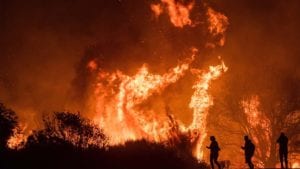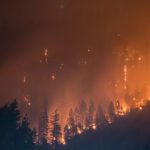
Yes, you need to shut off the power … 60-plus-mile-per-hour winds whipping down the mountains, ample dry vegetation in their path, and a significant population in the wildland-urban interface (WUI) with unassuming residential areas beyond.
These conditions set the stage for catastrophic fires, including those in Eaton Canyon in Los Angeles, California, in 2025, and in Lahaina, Hawaii, in 2023.
In both cases, the first question utilities faced was this: Why was the power still on under those conditions? That is, why did Southern California Edison and Hawaii Electric fail to implement public safety power shutoffs, which may have prevented these fires and the damage and loss of life that accompanied them?
COMMENTARY
As wildfire risks intensify due to climate change, extended drought conditions, and growing development in the WUI, other utilities across the country will face the same questions if they fail to appropriately anticipate and prepare for fire risk conditions.
A Public Safety Power Shutoff (PSPS) is an important mitigation tool that enables utilities to proactively de-energize sections of the grid when forecasted or actual weather conditions create a heightened risk of wildfire ignition. Since the strategy was first utilized in California, where having PSPS procedures is required for investor-owned utilities, all utilities should have PSPS procedures in place and be prepared to initiate them not if, but when, conditions within their territory warrant doing so. Implementing PSPSs is critical as utilities seek to manage the increasing scale of legal and financial risk posed by catastrophic wildfires.
Across the West, an area where fire has always been a part of the landscape and much of it could burn for part of any year, PSPS has been a critical stopgap for utility wildfire prevention. PSPS protocols can be implemented quickly and cheaply while more costly and time-consuming modernization measures, such as covered conductor and undergrounding, can be completed. But electric infrastructure is aging across the country, and the rising incidence of climate change-related extreme weather events is rapidly outpacing modernization efforts everywhere.
Beyond inflating the risk in traditionally fire-prone landscapes in the West, climate change is pushing extreme wind, heat, and drought conditions into new geographies with each passing year. As a result, fires have grown in size across many geographies, and wildland fires have cropped up in unexpected places.
According to the National Interagency Fire Center, in 2024 across the Eastern U.S (from Missouri to Maine, north of Kentucky), there was more than a 150% increase over the 10-year average in acres burned in wildfires. Wildfires threatened new and unexpected territories including for example forested regions of New Jersey and even Prospect Park in New York City. The same year, the South, from Texas to Florida, experienced a 95% increase over the 10-year average, including the largest wildfire in Texas history, the Smokehouse Creek Fire, sparked by a downed power line.
It is only a matter of time before all utilities, even those in historically lower-risk geographies, will need to contend with the reality of these trends. Broadly implemented PSPS protocols will enable utilities to cope with lagging infrastructure upgrades and reduce their risk within weeks, not years.
Many are moving toward this reality. According to the “State of the Interconnection” report, developed and published by the Western Electricity Coordinating Council, 2025 saw a 50% increase in the number of entities that included PSPS in their wildfire mitigation plans.As an example Rocky Mountain Power just executed, in June 2025, the first PSPS in Utah.
Utilities that have utilized PSPS understand that having a well-planned and well-managed protocol is critical to successful implementation. PSPS events have been the subject of intense scrutiny due to miscommunication and mismanagement. There has been significant backlash when outages have been extensive in scope and duration. Communications to customers have been missing, confusing, or inconsistent; impacts on critical and essential services and vulnerable populations have not been well managed; and the perception that utilities are substituting PSPS protocols for necessary infrastructure investment has grown.
Preventing these breakdowns in communication or trust starts from the beginning of PSPS planning. PSPS requires a clear understanding and definition of the risk triggers that will require a power shutoff. These could include wind speed and humidity, drought, or fuel load conditions. It is important to tailor these criteria to the unique weather and infrastructure conditions of an area wherever possible. Utilities that fail to properly define PSPS triggers face either unwarranted shutoffs or missed opportunities to prevent catastrophe.
Still, the phrase “public safety” comes before “power shutoff” in PSPS for a reason. Many PSPS failures stem not from the shutoff itself but from customer confusion or chaos during the PSPS. The best practice is that communication with the public should start as long before a potential PSPS event as possible, ideally giving customers and community partners at least several days’ notice if PSPS triggers are forecasted, reminding them of expectations and procedures. As part of and beyond this pre-communication, customers should be notified in tiers, beginning with critical facilities and the medically sensitive, followed by the general public.
Although PSPS is a necessary tool for safety and resilience, it is not a magic wand. Communication and planning are necessary for success. Community partners are also critical to PSPS success, particularly to protect critical facilities and medically sensitive customers. Local non-utility emergency management agencies, first responders, hospitals and other arms of the healthcare system, and key private-sector players have important roles to play in supporting community members in the event of a power shutoff, and they must be properly informed and engaged to play that role well. Outfitting community resource centers with charging stations and support is not enough; transportation, community engagement, and community knowledge and understanding are needed.
PSPS messaging should be consistent, simple, and aligned across call centers, media, and local officials. Utilities should have dedicated PSPS teams with messaging methods and materials prepared in advance. A PSPS team should be a permanent function not an ad hoc working group. Utilities should not be “winging it” amid a red flag warning. Communication and careful planning are critical. Poor execution likely will result in angry ratepayers and consumers before and during a PSPS; when communication and planning are effective, customers should be asking, “Why is my power still on?” during red flag warnings.
PSPS is not the only tool for wildfire mitigation and should not be a stand-alone solution. It fits into the larger wildfire mitigation planning landscape and complements other initiatives, like infrastructure hardening and upgrades, vegetation management, and regular inspections.
We know, implementing a PSPS goes against what system operators and indeed the utility leaders and staff stand for: providing reliable and consistent power. However, as climate-driven wildfire threats continually expand and become increasingly unpredictable, utilities can no longer treat PSPS as optional or a last resort. When thoughtfully implemented, PSPS is an immediate and scalable tool to reduce ignition risk, especially in the face of aging infrastructure and delayed modernization. The effectiveness of PSPS hinges not just on technical readiness, but on trust: utilities must plan ahead, communicate clearly, and collaborate with communities and critical partners. The key question utilities must be prepared to answer is not whether they turned the power off too soon, but whether they acted early enough to prevent the next disaster.
—Matthew Moore of Charles River Associates is an experienced power industry consulting professional who advises utilities, government and quasi-government agencies, independent power producers, and independent system operators on regulatory strategy and compliance.









